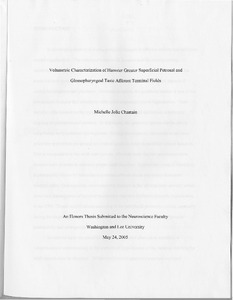| dc.rights.license | In Copyright | en_US |
| dc.creator | Chastain, Michelle Jolie | |
| dc.date.accessioned | 2023-10-20T15:49:19Z | |
| dc.date.available | 2023-10-20T15:49:19Z | |
| dc.date.created | 2005 | |
| dc.identifier | WLURG038_Chastain_thesis_2005 | |
| dc.identifier.uri | https://dspace.wlu.edu/handle/11021/36252 | |
| dc.description.abstract | In developing sensory systems, perinatal changes in afferent activity can influence central organization. The continual turnover of receptor and the corresponding maintenance of appropriate afferent innervation of newly born taste receptor cells has made the taste system an attractive model for the investigation of several aspects of neural development and plasticity. Dynamic in nature, the gustatory system is one of the few sensory systems that constantly undergoes degeneration and regeneration. Taste receptor cells located on the oral, pharyngeal, and laryngeal epithelium experience ongoing degeneration and renewal. In this sense, the gustatory system can be said to recapitulate early neuronal development. . . . In order to study the possibility of developmental changes in structure, a comprehensive understanding of the anatomical organization of the terminal fields in the adult animal must be obtained. While much central gustatory structure has been described in considerable detail, a more macroscopic characterization of the spatial organization and interrelation of the major taste afferent terminal fields has been overlooked. The present study is a first step toward establishing normative adult data that describe, in quantitative terms, the volumetric and spatial relationship of the greater superficial petrosal (GSP), chorda tympani (CT), and glossopharyngeal (GX) nerves. We provide here a quantitative characterization of the NTS terminal fields of the GSP and GX nerves in the adult hamster as well as regions of overlap between them. To our knowledge, this is the first demonstration of GSP terminal field in this species as well as the first demonstration of simultaneously labeled terminal fields. This thesis begins with an overview of basic gustatory anatomy (peripheral and central) followed by a brief synopsis of the literature regarding the plastic changes that occur in the developing gustatory system. [From Introduction] | en_US |
| dc.format.extent | 39 pages | en_US |
| dc.language.iso | en_US | en_US |
| dc.rights | This material is made available for use in research, teaching, and private study, pursuant to U.S. Copyright law. The user assumes full responsibility for any use of the materials, including but not limited to, infringement of copyright and publication rights of reproduced materials. Any materials used should be fully credited with the source. | en_US |
| dc.rights.uri | http://rightsstatements.org/vocab/InC/1.0/ | en_US |
| dc.subject.other | Washington and Lee University -- Honors in Neuroscience | en_US |
| dc.title | Volumetric Characterization of Hamster Greater Superficial Petrosal and Glossopharyngeal Taste Afferent Terminal Fields | en_US |
| dc.type | Text | en_US |
| dcterms.isPartOf | WLURG038 - Student Papers | en_US |
| dc.rights.holder | Chastain, Michelle Jolie | en_US |
| dc.subject.fast | Taste -- Physiological aspects | en_US |
| dc.subject.fast | Hamsters as laboratory animals | en_US |
| dc.subject.fast | Chemical senses -- Research | en_US |
| local.department | Neuroscience | en_US |
